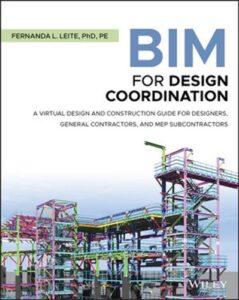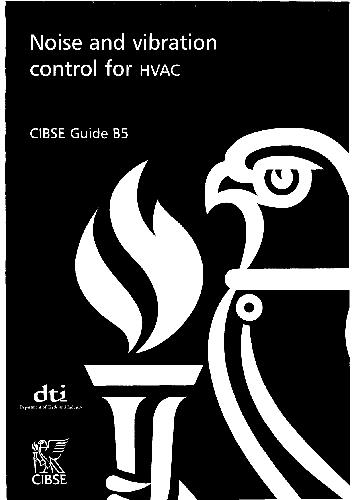| Book Name: | BIM for Design Coordination by Fernanda L. Leite |
| Language: | English |
| Format: | |
| Free Download: | Available |
BIM for Design Coordination a Virtual Design and Construction Guide for Designers, General Contractors, and Mep Subcontractors by Fernanda L. Leite | PDF Free Download.
BIM for Design Coordination
| Book Details : | |
|---|---|
| Language | English |
| Pages | 180 |
| Format | |
| Size | 11.4 MB |

BIM for Design Coordination by Fernanda L. Leite
Author of BIM for Design Coordination PDF
Dr. Fernanda Leite, P.E., is an associate professor in construction engineering and project management and a provost teaching fellow in the Civil, Architectural, and Environmental Engineering (CAEE) Department at the University of Texas at Austin. She holds the Mrs. Pearlie Dashiell Henderson Centennial Fellowship in Engineering.
She has a Ph.D. in civil and environmental engineering from Carnegie Mellon University. Prior to her graduate education, she worked as a project manager in her home country, Brazil, in multiple government infrastructure and commercial building construction projects.
Since starting at the University of Texas in January 2010, she has served as co-principal and principal investigator in approximately $8 million in externally funded research.
She has co-authored over 100 refereed journal articles, book chapters, conference publications, and reports.
Her technical interests include information technology for project management, building information modeling, collaboration, and coordination technologies, and information technology-supported construction safety management.
At the University of Texas, Dr. Leite teaches courses in building information modeling, project management and economics, and construction safety.
She serves as a graduate program coordinator for CAEE’s sustainable systems cross-disciplinary graduate program and on the executive committee for the university-wide bridging barriers effort called Planet Texas 2050.
To date, she has supervised 15 Ph.D. and 40 master’s degree students. She serves as an associate editor for the journal Automation in Construction.
Dr. Leite has been honored with several awards, including the American Society of Civil Engineers (ASCE) Daniel W. Halpin Award for Scholarship in Construction (2019), the Construction Industry Institute (CII) Outstanding Researcher Award (2018), the ASCE Thomas Fitch Rowland Prize (2018),
Fiatech’s Superior Technology Achievement (STAR) Award (2016), and Fiatech’s Celebration of Engineering and Technology Innovation (CETI) Award for Outstanding Early Career Researcher (2013).
BIM for Design Coordination Contents
- IntroductionSetting Up the Project for success
- Model Quality
- Carrying Out a Successful Design Coordination Session
- Specific Guidelines for General Contractors and the VDC Coordination Team
- Specific Guidelines for Architects and Engineers
- Specific Guidelines for Subcontractors and Fabricators
- BIM-Based Design Coordination in Other Industry Sectors
- BIM Teaching Considerations
- What the Future Holds for Design Coordination
Preface to BIM for Design Coordination eBook
While still an undergraduate student in my native country, Brazil, I interned for a construction company and performed rudimentary paper-based design coordination.
I compared drawings that were submitted by various specialty engineering firms, each working independently on their scopes of work and not collaborating with one another.
My job was seemingly simple: to identify physical conflicts between the various scopes of work based on two-dimensional drawings. I performed the comparison as systematically as possible but did not even have a light table to help.
I had the hard-copy drawings opened up side-by-side on a large meeting table. Often, the drawings that I was comparing, all from different design firms, were not even printed on the same scale. So that seemingly simple task became a geometric nightmare, with design intent often lost in translation.
That resulted in numerous field-detected issues, which was viewed as business as usual. Luckily, this was a high-rise residential tower, in which each floor was identical to all the others.
Hence, once the issues were detected and documented on the first floor, all other 24 floors benefitted from those lessons.
In this case, the first floor served as a prototype for the rest of the tower. A physical, real-world, expensive prototype.
It is worth noting that the Brazilian building construction market differs significantly from the United States. In Brazil, the construction entity is typically the owner-developer, leading to less fragmentation, at least from the construction site.
However, from a design perspective, it is similarly fragmented. That fragmentation and this early internship experience are where my curiosity related to design coordination began.
Years later, while pursuing my Ph.D. at Carnegie Mellon University, I began working with building information modeling (BIM) and had the opportunity to experience BIM being implemented on a campus project for the first time, in a large new building.
This was in the early days of BIM, in the mid-2000s. I was charged by the general contractor (GC), who was also new to BIM, with figuring out ways to leverage BIM in the project. One of the opportunities turned out to be design coordination.
The idea came about when I showed up for a design coordination meeting early morning in the middle of a Pittsburgh winter. In attendance were the GC’s project manager, an owner’s representative, a couple of design team members from out of state, and heating, plumbing, fire safety, electrical, and sheet metal subcontractors.
That was the kickoff meeting for design coordination. Construction had just started. The project manager and I had a BIM model for the project, which was initially developed by third-party modelers based on 85% complete 2D architectural, structural, mechanical, electrical, plumbing, and fire protection (MEPF) drawings.
The MEPF included all elements larger than 1.5”. When construction for the building’s underground garage was being built, the GC received a new BIM, based on 100% complete drawings. That was the version that was offered in this kickoff design coordination meeting.
We suggested that the subcontractors leverage that BIM model and use it as a starting point for design coordination.
The subcontractors in the room strongly pushed back, arguing that the use of BIM or 3D was not in their contract and most of them did not have the in-house capability to develop fabrication drawings in 3D (although some already designed in 3D, but reduced their submittals to the contractually established 2D drawings).
They also argued, “we’ve always done it this way and the projects turned out just fine.” Given the contract argument and seeing that we were not getting buy-in, we decided to carry on with the design coordination in the traditional process, overlaying 2D drawings on a light table.
At the same time, I realized that would give me a unique opportunity of collecting ground truth data for my own research.
Hence, I attended many months of these 2D design coordination sessions for this project, meticulously collecting data on which pairs of trades were coordinating each day, which area of the project they were coordinating for, which clashes they were finding, and what sorts of questions were they asking each other during the coordination process.
After each meeting, I would go to my graduate office and run clash detection on the BIM model for the same pair of trades and area that was the focus of that day’s meeting. I then compared the results.
That led to the first study that compared precision and recall, and implications of model quality on design coordination performed in 2D and 3D.
The results are provided in detail in chapter 3 of this book. After my Ph.D., I joined the University of Texas at Austin in January 2010 and developed UT’s first BIM course in the School of Engineering. It was first offered in fall 2010 and initially only to graduate students.
The focus was on BIM for construction engineering and project management. I cover topics ranging from model-based cost estimating, scheduling and 4D simulation, and design coordination.
This course is heavily influenced by my observations and discussions with industry partners, who have continuously challenged me to ensure students are getting the latest and most rewarding learning experiences they can.
My course is described in detail in chapter 9. A large part of the course is on design coordination and throughout the years, I have delivered this course module – as well as other modules – with a patchwork of reference materials.
That is where I saw the need to formalize design coordination knowledge, industry best practices, examples, and process guidelines in a consolidated place.
In the last two decades, I have observed a wide range of design coordination practices and my hope with this book is to provide a common starting point, from which both companies and students can build on and make their own while learning from others that came before them.
Download BIM for Design Coordination by Fernanda L. Leitein PDF Format For Free.
Related More Books
See More POST On : Engineering Books









![[PDF] Draw Buildings and Cities in 15 Minutes Draw Buildings and Cities in 15 Minutes pdf](https://www.freepdfbook.com/wp-content/uploads/2021/06/Draw-Buildings-and-Cities-in-15-Minutes-218x150.jpg)








![[PDF] Digital Image Processing An Algorithmic Introduction Using Java Digital Image Processing An Algorithmic Introduction Using Java](https://www.freepdfbook.com/wp-content/uploads/2022/06/Digital-Image-Processing-An-Algorithmic-Introduction-Using-Java.jpg)




![[PDF] 43 Years JEE ADVANCED + JEE MAIN Chapterwise & Topicwise Solved Papers 43 Years JEE ADVANCED (1978-2020) + JEE MAIN Chapterwise & Topicwise Solved Papers Physics PDF](https://www.freepdfbook.com/wp-content/uploads/2022/03/43-Years-JEE-ADVANCED-1978-2020.jpg)

![[PDF] Problems in Physical Chemistry for JEE (Main & Advanced) Problems in Physical Chemistry for JEE (Main & Advanced) Free PDF Book Download](https://www.freepdfbook.com/wp-content/uploads/2022/03/Problems-in-Physical-Chemistry-for-JEE-Main-Advanced.jpg)
![[PDF] Engineering Physics (McGraw Hill)](https://www.freepdfbook.com/wp-content/uploads/2021/05/bafc8c2685bb6823a9c56134f7fba5df.jpeg)

![[PDF] Engineering Chemistry By Shashi Chawla](https://www.freepdfbook.com/wp-content/uploads/2022/05/Theory-And-Practicals-of-Engineering-Chemistry-By-Shashi-Chawla-free-pdf-book.jpeg)
![[PDF] Chemistry: An Introduction to Organic, Inorganic & Physical Chemistry Chemistry: An Introduction to Organic, Inorganic & Physical Chemistry](https://www.freepdfbook.com/wp-content/uploads/2022/04/Chemistry-An-Introduction-to-Organic-Inorganic-Physical-Chemistry.jpg)
![[PDF] Essentials of Physical Chemistry Essentials of Physical Chemistry Free PDF Book by Bahl](https://www.freepdfbook.com/wp-content/uploads/2022/04/Essentials-of-Physical-Chemistry-bahl.jpg)
![[PDF] Biological control of plant-parasitic nematodes: soil ecosystem management in sustainable agriculture Biological control of plant-parasitic nematodes: soil ecosystem management in sustainable agriculture](https://www.freepdfbook.com/wp-content/uploads/2022/05/Biological-control-of-plant-parasitic-nematodes-soil-ecosystem-management-in-sustainable-agriculture.jpg)
![[PDF] Human Anatomy: Color Atlas and Textbook Human Anatomy: Color Atlas and Textbook Free PDF Book](https://www.freepdfbook.com/wp-content/uploads/2022/05/Human-Anatomy-Color-Atlas-and-Textbook.jpg)
![[PDF] Concepts of Biology Book [Free Download]](https://www.freepdfbook.com/wp-content/uploads/2022/05/Concepts-of-Biology.jpg)
![[PDF] Essentials of Biology [Free Download] Essentials of Biology Free PDF BOok Download](https://www.freepdfbook.com/wp-content/uploads/2022/05/Essentials-of-Biology-Free-PDF-Book-Downlaod.jpg)
![[PDF] Human Biology Book [Free Download]](https://www.freepdfbook.com/wp-content/uploads/2022/05/PDF-Human-Biology-Book-Free-Download.jpg)


